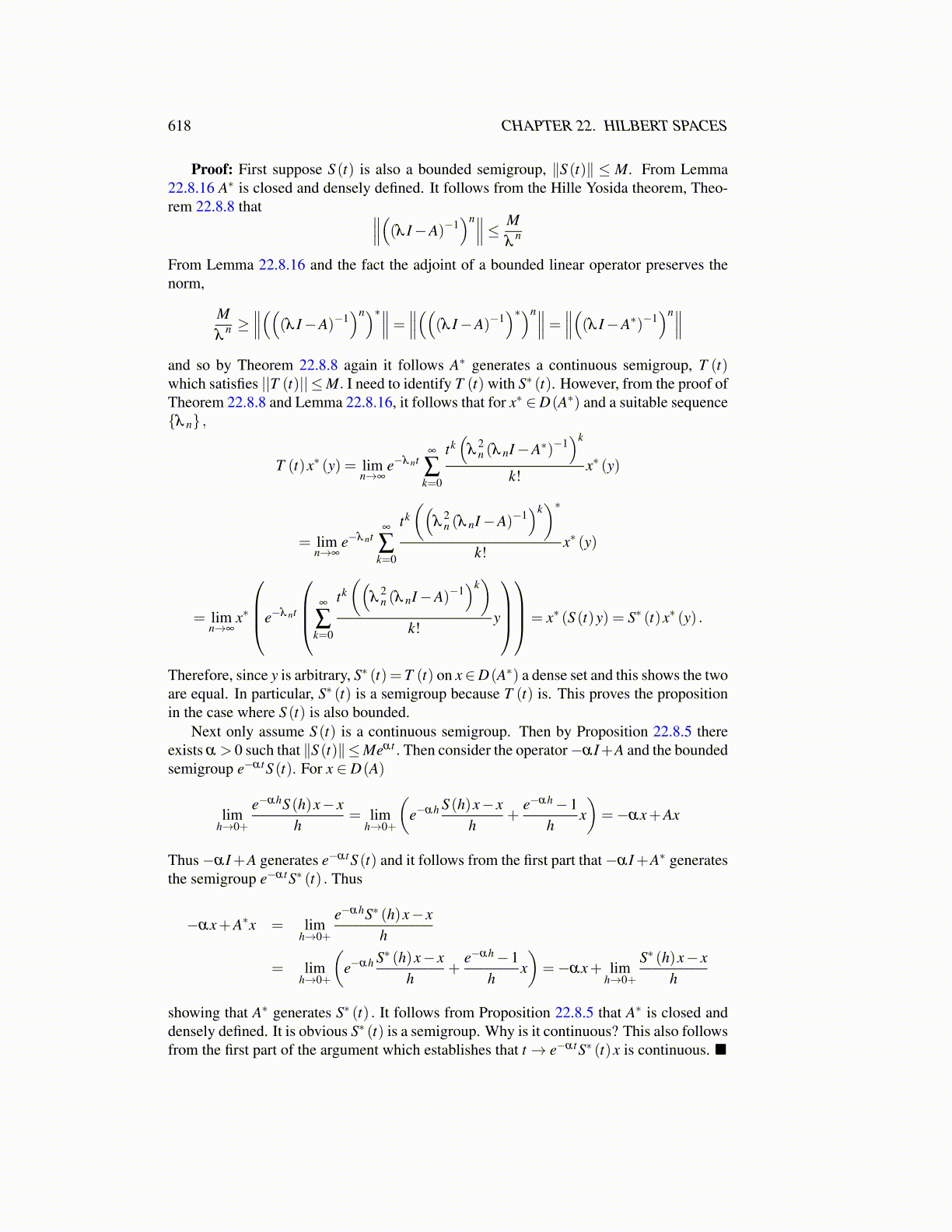
618 CHAPTER 22. HILBERT SPACES
Proof: First suppose S (t) is also a bounded semigroup, ∥S (t)∥ ≤ M. From Lemma22.8.16 A∗ is closed and densely defined. It follows from the Hille Yosida theorem, Theo-rem 22.8.8 that ∥∥∥((λ I−A)−1
)n∥∥∥≤ Mλ
n
From Lemma 22.8.16 and the fact the adjoint of a bounded linear operator preserves thenorm,
Mλ
n ≥∥∥∥(((λ I−A)−1
)n)∗∥∥∥= ∥∥∥(((λ I−A)−1)∗)n∥∥∥= ∥∥∥((λ I−A∗)−1
)n∥∥∥and so by Theorem 22.8.8 again it follows A∗ generates a continuous semigroup, T (t)which satisfies ||T (t)|| ≤M. I need to identify T (t) with S∗ (t). However, from the proof ofTheorem 22.8.8 and Lemma 22.8.16, it follows that for x∗ ∈D(A∗) and a suitable sequence{λ n} ,
T (t)x∗ (y) = limn→∞
e−λ nt∞
∑k=0
tk(
λ2n (λ nI−A∗)−1
)k
k!x∗ (y)
= limn→∞
e−λ nt∞
∑k=0
tk((
λ2n (λ nI−A)−1
)k)∗
k!x∗ (y)
= limn→∞
x∗
e−λ nt
∞
∑k=0
tk((
λ2n (λ nI−A)−1
)k)
k!y
= x∗ (S (t)y) = S∗ (t)x∗ (y) .
Therefore, since y is arbitrary, S∗ (t)= T (t) on x∈D(A∗) a dense set and this shows the twoare equal. In particular, S∗ (t) is a semigroup because T (t) is. This proves the propositionin the case where S (t) is also bounded.
Next only assume S (t) is a continuous semigroup. Then by Proposition 22.8.5 thereexists α > 0 such that ∥S (t)∥≤Meαt . Then consider the operator−αI+A and the boundedsemigroup e−αtS (t). For x ∈ D(A)
limh→0+
e−αhS (h)x− xh
= limh→0+
(e−αh S (h)x− x
h+
e−αh−1h
x)=−αx+Ax
Thus−αI+A generates e−αtS (t) and it follows from the first part that−αI+A∗ generatesthe semigroup e−αtS∗ (t) . Thus
−αx+A∗x = limh→0+
e−αhS∗ (h)x− xh
= limh→0+
(e−αh S∗ (h)x− x
h+
e−αh−1h
x)=−αx+ lim
h→0+
S∗ (h)x− xh
showing that A∗ generates S∗ (t) . It follows from Proposition 22.8.5 that A∗ is closed anddensely defined. It is obvious S∗ (t) is a semigroup. Why is it continuous? This also followsfrom the first part of the argument which establishes that t→ e−αtS∗ (t)x is continuous. ■